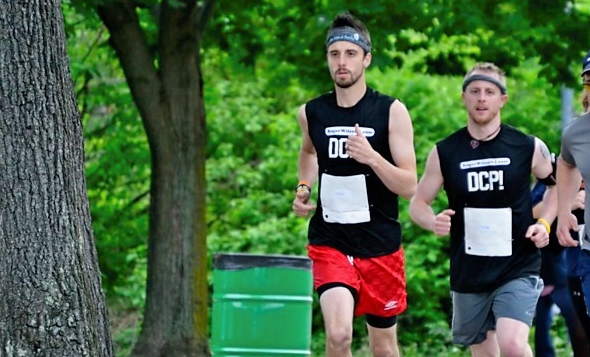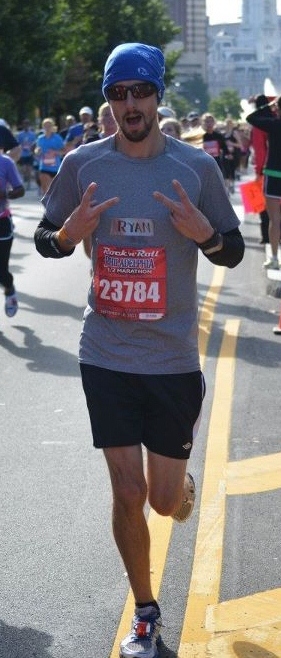My favorite aspect of Strength Running is helping runners completely transform their lives.
I love success stories because they’re great case studies on what others can do to improve so they can finally reach their goals of feeling healthy, energetic, and in better shape.
Overweight? Here’s how to lose 80 pounds.
Not running fast? Here’s how to PR without trying.
In a rut and don’t know what to do? Here’s how to place in your age group.
Today, I want to talk about how Ryan W. turned his running around – from barely finishing a marathon because of ITBS to running pretty damn fast at the Philadelphia Marathon.
“The most grueling race I have ever endured”

Ryan’s first marathon was in 2011 and like a lot of other runners, his training was all over the place.
He remembers, “I would start one generic training plan I found online or in a magazine and then switch to another and then another. I wasn’t a hundred percent confident that the plan was right for me, so I would choose a different one. Obviously bouncing from one plan to another is going to give you bad results.”
And bad results he got: while his time of 4:20 at the New Jersey Marathon is very respectable, it sure didn’t feel good. Halfway through the race, both of his IT bands became incredibly painful at the knee. Ryan recalled, “the second half of the marathon was the most grueling run, let alone race, I have ever endured.”
Ouch.
Ryan’s story is unfortunately all too common. He had no consistency in his training and wasn’t doing the body maintenance that his body specifically needed to stay healthy. Some runners need better workouts. Others need more strength work.
Different runners have different needs. Some can get away with doing the bare minimum for awhile – but it will always catch up to them. Especially over 26.2 miles on pavement where weaknesses are magnified and inefficiencies are exposed.
“The training is dead-on”
Ryan was frustrated. He wanted to tackle another marathon because he knew he could do better but was scared of re-injuring himself (I felt the same way after my ITBS and the NYC Marathon).
But fear isn’t a legitimate barrier to people with big goals. He knew another marathon was in his future and he just needed a way to get there – healthy and in better shape. Some runners might make excuses like, “I’ll never feel strong enough” or “The timing of my next marathon will never be right.”
Ryan took action and signed up for a PR Race Plan. He said, “Once I came across the plan I was sold. The price was right, I had the ability to ask questions to make sure I was doing it right and it gave me the confidence I needed to stick it out. It was customized to my needs, particularly my IT band issues and much cheaper than hiring a full time coach, which I just couldn’t afford at the time.”
After looking over Ryan’s training, I knew there was a lot of room for improvement. The biggest struggle was helping him overcome his IT Band Syndrome so he could run healthy. Only then could we focus on specific marathon prep to better his time of 4:20.
Ryan’s transition to the new plan took some time but the upgraded training wasn’t that drastic. Changing your daily workouts too dramatically is a recipe for injury – not something I encourage.
Here’s what Ryan said of the new plan:
“The transition from my old training plan to the PR Race Plan wasn’t too hard. The largest difference was the constant volume. When your training bounces all over the place you are constantly making excuses. ‘Well this plan starts on a Monday so I’ll take the weekend off and start fresh next week.’ This would happen more than once. Once you get your PR plan and you are committed to finishing it, the biggest challenge is putting in the time and doing the mileage. The plan doesn’t ask anything ridiculous of you, just to do the work it takes to be healthy and prepared for your race, which in my case was 26.2 miles long. The training is dead-on.”
“The confidence I needed to get back out there and go hard on race day.”

So how did Ryan do?
First things first: his ITBS troubles are behind him. With the right training adjustments, strength exercises, and treatment approach he hasn’t had any problems with either of his IT bands since his first marathon. His second marathon went off without a hitch and he felt strong the entire way.
More importantly, his confidence is through the roof. He says,
“The reason the PR plan worked so well, other than the fact that it was built just for me, was the confidence it gave me to stick with it. I knew the training would work because it was MY plan. I was then more easily able to stick with it, that alone produced better results. On top of that the very specific workouts geared specifically for me produced results in leaps and bounds. I felt great and I think even more importantly after having such a bad result during my first marathon, it gave me the confidence I needed to get back out there and go hard on race day.”
Ryan went on to run the 2011 Philadelphia Marathon in 3:34:06 – 46 minutes faster than his New Jersey Marathon.
Running faster is always fun, but it isn’t the real success story behind Ryan’s improvement. Instead, it’s his motivation and confidence levels after he got a training plan completely personalized to his history, goals, and injury background.
Now his legs feel stronger and he’s much more confident running longer distances. He had this to say about his experience with his custom plan:
“Every aspect of this plan and my subsequent training became a positive result in my running. Because of the PR Race Plan my IT band issues are completely gone. I was able to run my second marathon in the same year without any IT band pain, whatsoever.”
What lessons did Ryan learn?
Ryan went through a roller coaster of emotion with his double ITBS injury, grueling race, and finally a complete transformation of his running. He’s a very different runner (healthy, faster, and more confident!) than he was a year ago.
So what’s changed? Here are three valuable lessons Ryan learned:
- Strength training is just as important as the running itself. It doesn’t matter how fast you could have run that race if you are sitting on the couch because of an injury.
- Once you find the plan that is right for you, stick with it. There is a formula that goes into a plan that includes base-building, recovery, rest, etc. All of these things are needed to give you the best results. So follow the plan and do what it says…if it says rest, then rest!
- When you set your sights on something, don’t give up. Even if your first marathon is a complete disaster, perseverance and sound advice can turn everything around.
Finally, he said this:
“It didn’t just feel like a cookie cutter plan with my name at the top. It addressed issues I had that I talked with Jason about and I could feel the changes as I followed the plan. At the end along with being more confident and injury free I was also faster…a lot faster! I would and already do recommend this plan to everyone. Especially those who have had recent preventable running injuries, you can’t go wrong with this plan.”
I’m truly humbled to have been a part of Ryan’s journey. He’s kicking ass these days and feeling great and that’s all that matters.
Here’s to an even better 2012!
If you’re interested in learning more about the PR Race Plan, you can check out the full details here.
